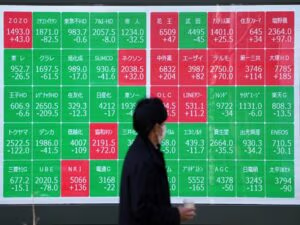The U.S. dollar was hovering near three-week lows on Friday ahead of payrolls data that will likely influence the outlook for rates, while the pound was firm as the Labour party took the UK general election in a massive win.
Sterling was last at $1.27575, little changed in early trading and not far off a three-week high of $1.27765 touched on Wednesday. It is up 0.9% for the week, marking its best weekly performance since mid-May and remains the strongest-performing major currency against the dollar this year with a gain of 1.2%.
“The Pound Sterling has strengthened against the US dollar as the US labour market loses momentum. Investors expect the Fed to begin lowering interest rates in September, and economists expect that the Starmer-led Labour Party will gain an absolute majority. The GBP/USD jumps higher amid growing speculation that the Fed will start reducing interest rates from the September meeting,” said Mohamed Hashad, Chief Market Strategist, Noor Capital
The Centre-left UK Labour Party sweep in its historic election win enabled affording investors some much-needed certainty after years of market volatility under the Conservatives
The euro was little changed at $1.0816 as traders refrained from making major bets with France gearing up for the run-off election on Sunday. Polls suggest the far-right National Rally (RN) is likely to fall short of a majority. The single currency, which has been under pressure since French elections were called in June, is up nearly 1% for the week and on track for its strongest weekly performance of the year.
While worries that RN could gain a majority and introduce big spending increases have receded, the country is headed for a hung parliament which is likely to weigh on sentiment, analysts said.

“It’s hard to see a dynamic where any fiscal measures of substance are passed in France,” said Chris Weston, head of research at Pepperstone.
U.S. traders return from their July 4th holiday and the spotlight will firmly be on non-farm payrolls, due later on Friday. The report is expected to show an increase of 190,000 jobs in June after a rise of 272,000 in May, according to a Reuters poll of economists.
A slew of economic data showing a cooling U.S. economy has heightened expectations the data-sensitive Federal Reserve will cut rates sometime soon. Traders are pricing in a 73% chance of a cut in September, according to the CME FedWatch tool. Markets are also pricing in potentially two rate cuts this year, although the Fed last month forecast just one rate cut for 2024. Much will depend on upcoming data.
“A softer (payrolls) print should further boost rate cut expectations and add to USD downside,” said Christopher Wong, an FX strategist at OCBC.
The dollar index, which measures the U.S. currency against six rivals, was down 0.1% at 105.05, close to its lowest point since mid-June.
The yen was 0.16% higher, up for a second straight day – something that hasn’t happened since the start of June. It last fetched $161.095 per dollar, crawling slowly away from the 38-year low of 161.96 on Wednesday.
Traders have been wary of Japanese authorities intervening in the market to prop up the currency which has lost more than 12% against the dollar this year, weighed down by the wide interest rate difference between Japan and the United States. Tokyo spent some 9.8 trillion yen in late April and early May to intervene in the currency market when the yen hit a then 34-year low of 160.245 per dollar. Analysts say, however, that authorities will focus on the pace of yen weakening and not just the levels.
In other currencies, the Australian dollar rose 0.16% to $0.6736, hovering near six-month highs, while the New Zealand dollar stood at $0.6121.
Bitcoin fell 2% to $57,088, just shy of the two-month low it hit on Thursday.






